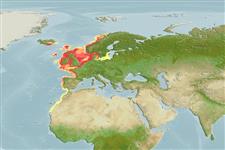Common names from other countries
Environment: milieu / climate zone / depth range / distribution range
Ecologie
; brakwater; diepteverspreiding 0 - 200 m (Ref. 2779), usually 0 - 6 m (Ref. 114208). Subtropical; -1°C - 22°C (Ref. 114208), preferred 12°C (Ref. 107945); 70°N - 22°N, 20°W - 19°E (Ref. 114232)
Eastern Atlantic: From Great Britain north to Iceland, the North Sea and Norway, south to Portugal and Spain to Mauritania. Introduced and established in North America, South Africa (Cape Town), and Australia. Introduced but not established in Panama, Brazil, Pakistan, Sri Lanka, Madagascar, Myanmar, Japan and Hawaii. Subtropical to polar.
Length at first maturity / Size / Gewicht / Leeftijd
Maturity: Lm ?, range 1 - 4.5 cm Max length : 6.0 cm CL mannelijk/geslacht niet bekend; (Ref. 435); common length : 4.0 cm CL mannelijk/geslacht niet bekend; (Ref. 435); Maximaal vermelde leeftijd: 7 jaren (Ref. 128193)
Usually found in eelgrass beds (Ref. 128717). Maximum carapace width: 7.7 cm; commonly 5 cm wide.
Members of the order Decapoda are mostly gonochoric. Mating behavior: Precopulatory courtship ritual is common (through olfactory and tactile cues); usually indirect sperm transfer (Ref. 833). Berried females migrate from littoral areas to more saline and deeper water (8-10 m) until hatching of eggs; afterwhich, they go back to moult and copulate (Ref. 128197). Larger females can breed twice or thrice annually (Ref. 128203).
Fischer, W., G. Bianchi and W.B. Scott (eds.). 1981. (Ref. 435)
Status op de Rode Lijst van het IUCN (Ref. 130435: Version 2024-1)
Status bij CITES (Ref. 108899)
Not Evaluated
Not Evaluated
Gebruik door de mens
Visserij: commercieel
FAO - Visserij: landings | FishSource | Sea Around Us
Tools
Internet-bronnen
Estimates based on models
Preferred temperature
(Ref.
115969): 7 - 12.7, mean 9.6 (based on 453 cells).
Kwetsbaarheid
Low to moderate vulnerability (28 of 100).
